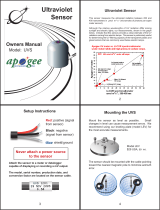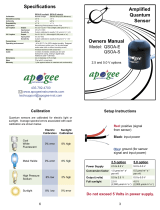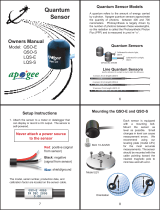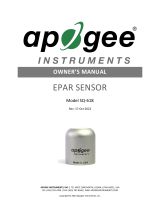Page is loading ...

5 6
7 8
Ultraviolet
Meter
UV Meter
300 to 400 nm
OFF
ON
Owners Manual
Model: UVM
UVM-SS
Ultraviolet Meter
This meter measures the ultraviolet radiation between
250 and 400 nanometers, in μmol m-2 s-1 (micromoles
of photons per square meter per second).
UVM UVM-SS
Handheld Readings
1. Turn the dial clockwise to the “on” position.
2. Handheld UV meters should be held level as shown
below. Separate sensors should be mounted on a
horizontal surface.
3. The number displayed is the μmol m-2 s-1
4. Turn the meter off after use to conserve battery
power.
Mounting the UVM-SS
Mount the sensor as level as possible. Small changes
in level can cause measurement errors. We recom-
mend using our leveling plate (model LEV) for the most
accurate measurements.
The sensor should be mounted with the cable pointing
toward the nearest magnetic pole to minimize azimuth
error.
N
S
Model LEV
$29 USA, $31 Intl.

5 6
7 8
Calibration
Although the relative wavelengths of UV radiation differ
among sunlight and electric lights, our measurements, shown
in the graph below, indicate that this sensor provides a close
estimate of the UV radiation coming from electric lamps. This
sensor is particularly useful for determining the UV ltering
capacity of the transparent plastic and glass barriers that are
commonly used below electric lamps.
Why this Meter cannot selectively
measure UV-B Radiation (280-320 nm)
Our measurements conrm those of others and indicate that less than
0.4 % of the photon ux from sunlight falls below 320 nm; 2.3 % falls
between 320 and 350 nm, and 6 % falls between 350 and 400 nm. Al-
though the UV radiation between 250 and 320 nm is critically important
in photochemical and photobiological reactions, only about 5 % of the UV
photons are in this range. Because only a small fraction of the photons
are in the UV-B range, this meter cannot be used to selectively measure
UV-B radiation. The sensor is sensitive to UV-B radiation, but it is included
with the UV-A radiation to provide a total measurement of UV radiation.
Effects on Output
Level
The meter or sensor must be exactly horizontal for the
most accurate measurement. The largest error is often
caused by small changes in the position of the sensor.
Separate sensors should be mounted with the cable
pointing toward the nearest magnetic pole.
Cosine response
Some of the radiation coming into a sensor at low
angles is reected, which causes the reading to be less
than it should be. The cosine-corrected head helps to
capture radiation at low angles. The cosine error for
typical applications is less than 10 %.
Temperature response
The temperature response is about 0.1 % per degree
celsius. This temperature error is insignicant for most
applications.
Long-term stability
The output of all radiation sensors tends to decrease
over time as the detector ages. Our measurements
indicate that the average output decreases about
1 % per year. We recommend returning the sensor
for recalibration every 3 years.
Specications
435-792-4700
www.apogeeinstruments.com
Range 0-199.9 µmol m-2 s-1
(full UV in sunlight: 170 µmol m-2 s-1)
Absolute Accuracy ± 10 %
Input power Standard 9 V battery
Operating environment 0 to 50 °C. Less than 90 % non-condensing,
relative humidity up to 30 °C. Less than 70% RH
from 30 to 50 °C.
Display 3 ½ digit, 1.2 cm height
Cable For separate sensor: 2 meters of shielded,
twisted-pair wire with Santoprene casing.
Dimensions Meter: 12.6 x 7 x 2.4 cm
Sensor: 2.4 cm diameter, 2.5 cm tall
Mass 150 g-UVM, 180 g-UVM
Warranty 1 year parts and labor
/



